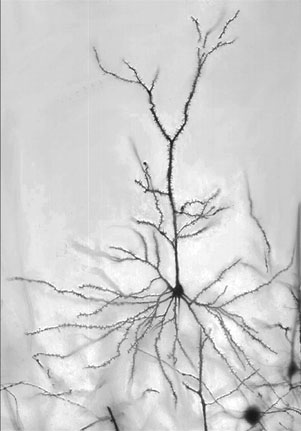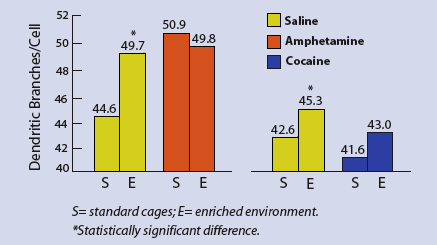Fresh experience grows our brains—literally. As we navigate novel situations, our brain cells sprout new fibers and form new synapses, weaving new communication networks that enrich our repertoire of responses to life. This growth process is called structural plasticity. According to new NIDA research, amphetamine and cocaine also stimulate structural plasticity, but with a catch: At least in rats, the stimulant-drug-induced growth appears to be associated with a reduced potential for subsequent experience-driven growth.
 A stained cell from the parietal cortex of a rat brain shows branching of cell dendrites—fibers that receive input from other brain cells (magnification, x250). Increased density of dendrites is a mark of structural plasticity, a process that expands communication among brain cells.
A stained cell from the parietal cortex of a rat brain shows branching of cell dendrites—fibers that receive input from other brain cells (magnification, x250). Increased density of dendrites is a mark of structural plasticity, a process that expands communication among brain cells."What we see in these animals suggests that repeated exposure to these two stimulant drugs limits the ability of later experiences to promote reorganization of synaptic connections in some brain regions," says Dr. Terry Robinson of the University of Michigan in Ann Arbor. "If there is a similar effect in humans, some of the behavioral and cognitive changes that result from new experiences may be limited by prior exposure to drugs. This drug-triggered mechanism may contribute to the persistent behavioral and cognitive deficits associated with drug abuse and addiction."
Dr. Robinson, at Michigan, and Dr. Bryan Kolb, at the University of Lethbridge in Alberta, Canada, and their colleagues examined the influence of cocaine and amphetamine on the growth of dendrites—filaments that grow out of brain cells and act as collectors of messages incoming from other cells. Intense proliferation of dendrite branches and spines (shorter projections that terminate in synapses) occurs when rats are put into challenging environments. In animals and people, such growth is thought to be an important part of normal learning, transforming experience and associations into changes in brain circuitry. In the present study, the scientists looked at what happens when drug exposure precedes exposure to a new, more stimulating environment.
The scientists injected some female rats with amphetamine and others with saline for 20 consecutive days. Amphetamine doses were comparable to those used by individuals addicted to the drug (0.5 mg/kg amphetamine on days 1 and 20, 4.0 mg/kg on days 2 through 19). The animals were then transferred from small, single-animal cages into new housing. Some went into standard double-size cages, three animals per cage; others went into large monkey cages divided into multiple levels and appointed with wire mesh bridges and ramps, tunnels of plastic pipe, ladders, and other items to interest and challenge the rats. After the rats had lived in their new environments for 3.5 months, the researchers assessed the dendrites in two areas of their brains, the nucleus accumbens (NAc) and the parietal cortex (PC). Compared with rats exposed to saline and raised in standard housing, animals that received saline and were moved to a complex environment had an increase of roughly 11 percent in dendrite density in both brain regions. By the same standard, animals exposed to amphetamine had an increase of roughly 14 percent in dendrite density in the NAc when raised in standard housing or more stimulating housing.
"We need to take into account the possibility that the cognitive capacity of drug abusers may be impaired and develop treatments that accommodate this impairment.""Both amphetamine and experience in the complex environment increased the number of branches and spines that developed on dendrites in the nucleus accumbens," says Dr. Kolb. "However, among the animals exposed to amphetamine, those transferred to the more stimulating environment had no more overall dendritic growth in the NAc after 3.5 months than did those in standard housing." Previous drug exposure seemed to exhaust the NAc cells' "budget" for growth, curtailing subsequent plasticity in the NAc.
In contrast to its impact in the NAc, amphetamine did not cause dendrites to grow in the PC, a region of the brain involved in allocating and switching attention among tasks. Rats that received saline exhibited more PC dendrite growth after placement in the enriched housing than after placement in standard housing, while rats given amphetamine grew no more in one environment than the other.
The researchers repeated their experiments, this time using cocaine (15 mg/kg) rather than amphetamine. In earlier work, the researchers determined that the doses of cocaine produced transient structural plasticity. After 3 months, there was no longer any evidence of cocaine-induced structural plasticity in either the NAc or the PC: Cocaine did, however, completely block the dendrite growth exhibited by saline-treated rats when both were kept in a stimulating environment for 3 months.
"This research suggests an alternative explanation for some of the cognitive and behavioral deficits associated with drug abuse," Dr. Robinson says. "Neuropsychological deficits in addicts are traditionally seen as evidence of either frank toxicity—the equivalent of a physical lesion—or at least a kind of 'functional lesion' that makes certain discrete regions of the brain unable to function properly. Our results suggest that some behavioral or psychological deficits resulting from drug abuse may be caused by drugs impairing the ability of some brain regions to make the changes that enable us to learn and profit from our experiences."
 Stimulant Drugs Inhibit Brain Cell Growth in Response to Environment. Relocating rats from standard cages to an enriched environment led to a significant increase in dendrite branching in the nucleus accumbens, but not if the rats were first exposed to amphetamine or cocaine.
Stimulant Drugs Inhibit Brain Cell Growth in Response to Environment. Relocating rats from standard cages to an enriched environment led to a significant increase in dendrite branching in the nucleus accumbens, but not if the rats were first exposed to amphetamine or cocaine.Drugs' destructive cognitive deficits have important implications for treatment, says Dr. Susan Volman of NIDA's Division of Neuroscience and Behavioral Research. "We need to take into account the possibility that the cognitive capacity of drug abusers may be impaired and develop treatments that accommodate this impairment."
Dr. Volman adds that Dr. Robinson's research does have a hopeful side: "This study examines synaptic structure and indicates that exposure to drugs alters the effects of subsequent environmental experience. That opens up the possibility that the reverse might also be true—exposure to enriching environments might alter the subsequent effect of drugs."
For now, says Dr. Robinson, the main practical lesson of the findings is that "the brain appears to have a finite amount of plasticity. If that's really the case, it's important to make sure that drugs don't get too big a share."
Source
- Kolb, B.; Gorny, G.; Li, Y.; Samaha, A-N.; and Robinson, T.E. Amphetamine or cocaine limits the ability of later experience to promote structural plasticity in the neocortex and nucleus accumbens. Proceedings of the National Academy of Sciences 100(18):10523-10528, 2003. [Abstract]
